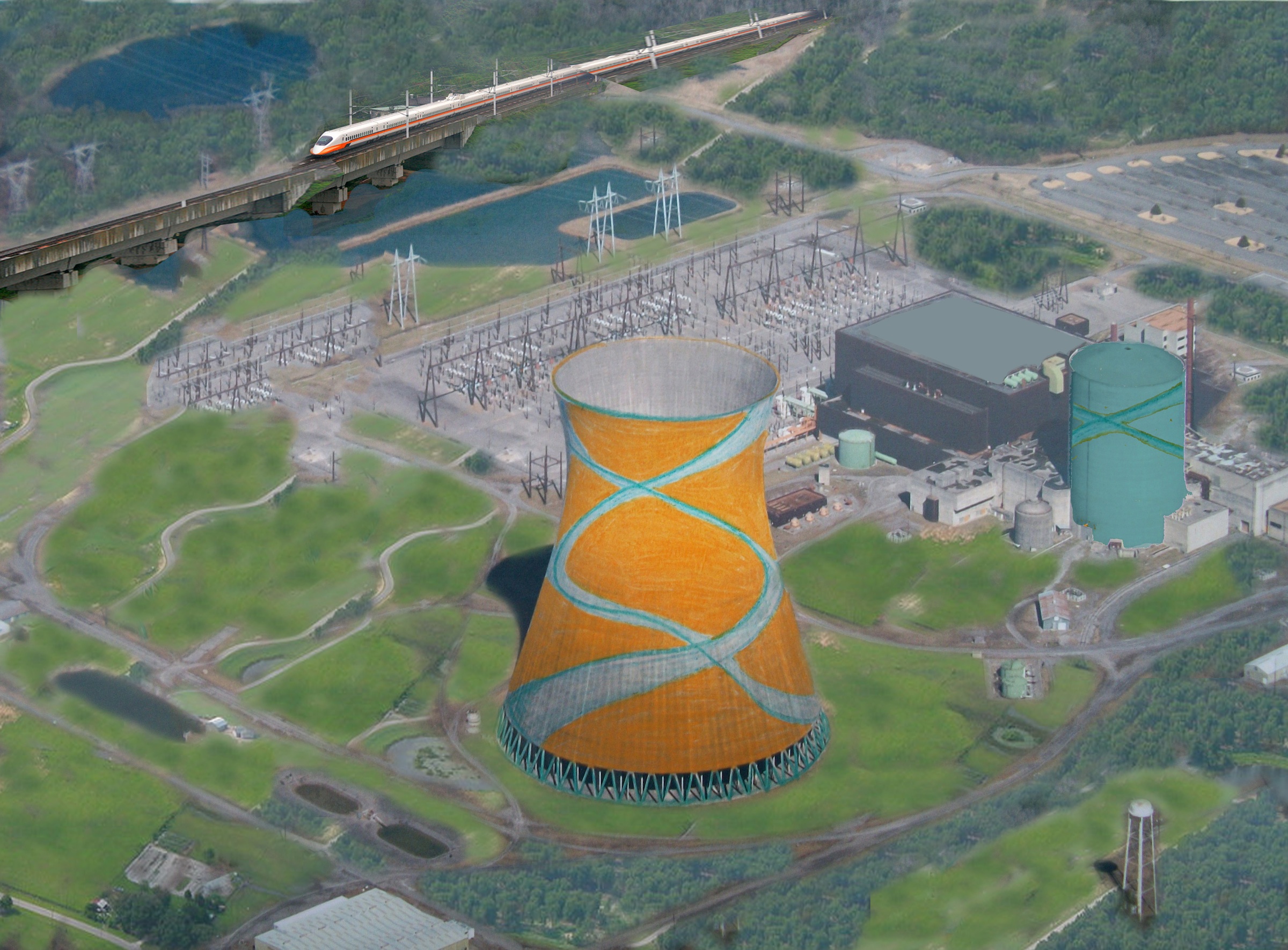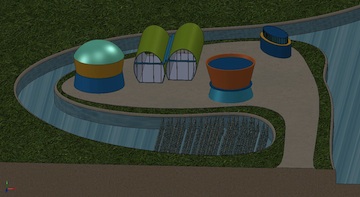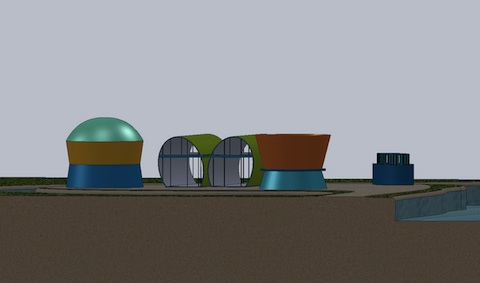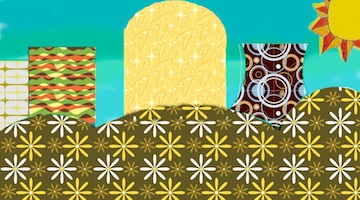The future of nuclear energy is (hopefully) better dressed
By Suzanne Hobbs
Nuclear energy is a little bit like an overly qualified job candidate in a bad suit. That is to say, despite being the best contender for the job of creating clean energy, no one wants to hire it because it needs a hair cut and a good tailor.
Luckily, some of the folks at the World Nuclear Association (WNA) have realized that appearance is important. The WNA put out a call in 2010 for new designs in its annual reactor design competition.
Improving the appearance of nuclear power plants is one of the founding tenets of PopAtomic Studios, so this competition was a dream come true for us. This was our chance to give a reactor a makeover and present it to a committee of highly regarded industry professionals. The vote is still out, but we wanted to go ahead and share our two designs that we entered into the competition, because we are just too excited to wait.
We approached the competition from two perspectives:
- A creative design model that can be applied to the numerous existing power plants that have been, or will be, relicensed.
- A design that shows how artistic touches and collaboration can be integrated into new power plants.

Our first design is something we have been advocating for since the formation of PopAtomic Studios: a colorful surface achieved using concrete stain. The result would have a tremendous visual impact, despite being low cost and low maintenance. This concept incorporates mass transportation and makes employment at a nuclear plant more convenient and appealing. These simple changes communicate respect for the community, and a commitment to clean energy.

Our second design focuses on collaborative relationships with several eco-friendly energy sources and strives for effective resource management. Energy parks are becoming increasingly popular and we wanted to create an example of how function and creative design can work together beautifully. The goal of this design is to affirm that nuclear energy is clean, modern, and a real team player; concurrently, it is rooted in a history of science and safety.

In our energy park (the illustration to the left is an overhead view of the illustration in the preceding paragraph), we have removed the cooling tower and replaced it with an onsite bio-fuels processing center (which is designed to look like a cooling tower). Using super-heated water from the fission reaction, we can create an ideal habitat for growing algae for fuel in the partial "moat" surrounding the plant. The moat doubles as a security measure. Recycled carpet "walls" in the moat allow for the algae to be easily harvested. Interface Flor, a company dedicated to using recycled synthetic flooring materials in eco-friendly ways, is currently developing a similar system as a part of a remediation project in the Chesapeake Bay.
Our goal is to promote the use 0f super-heated water as a resource rather than a byproduct, especially in contemporary energy parks. Super-heated water can be used in seawater desalination and production of hydrogen.
Once the water has cooled in the algae pond, it can be used to irrigate the land surrounding the plant to grow switch-grass for bio-fuels, which would not be in competition with crops for food. Double turbines offer electricity creation from fission, as well as a natural gas back-up/peak-generating turbine. The CO2 from the natural gas turbine can be pumped into the algae pond, creating a carbon-rich habitat for growing fuel, and keeping the plant carbon neutral.

Artistically, we wanted to honor the rich history of nuclear energy, while bringing plant design into the modern era. (The illustration to the left is yet another view of our second design.) The shape of the bio-fuels processing building is an artistic reference in that its cooling-tower look and the office building is inspired by the shape of the top of a nuclear submarine. The reactor buildings and turbines are updated with design elements that could be achieved through relatively minor exterior architectural changes to existing designs. The overall feel of the plant is a throwback to the Nuclear Era of the 1950s.
As artists, we realize that it will take more research and development to implement these ideas effectively, but we intend our designs to act as food for thought and inspiration for all of the great thinkers in the field. We support the idea of buying nuclear energy a really nice suit and introducing it to some new friends, like bio-fuels and natural gas.
Jeremy Gordon at the WNA was the competition organizer, as well as a patient guide to our team as we worked through the details of our designs. A very special thanks to Jeremy for bringing attention to this often-overlooked solution to the nuclear industry's public relations problems.
 We would also like to formally thank UxC for its generous sponsorship of our entries. Its support allowed us to put adequate time and energy into the development of our concepts, and to grow our outreach efforts at Chattahoochee Technical College, in Marietta, Ga. The illustration in this paragraph is a Chattahoochee student's interpretation of the WNA design competition. Happy New Year!
We would also like to formally thank UxC for its generous sponsorship of our entries. Its support allowed us to put adequate time and energy into the development of our concepts, and to grow our outreach efforts at Chattahoochee Technical College, in Marietta, Ga. The illustration in this paragraph is a Chattahoochee student's interpretation of the WNA design competition. Happy New Year!
 Suzanne Hobbs is creative director and contributing artist at PopAtomic Studios. She was born in Tokyo, Japan, and raised in Atlanta, Ga., by her nuclear engineer father and social worker mother, along with an older brother who is now an accomplished chemist. Her interest in art, science, and humanitarian issues started very young, fueled by frequent family travel and a sharp focus on education and community involvement. She attended Appalachian State University to study Fine Arts and since graduating has worked with several public arts organizations, always with the goal of using art to create positive change. She is a frequent contributor to the ANS Nuclear Cafe.
Suzanne Hobbs is creative director and contributing artist at PopAtomic Studios. She was born in Tokyo, Japan, and raised in Atlanta, Ga., by her nuclear engineer father and social worker mother, along with an older brother who is now an accomplished chemist. Her interest in art, science, and humanitarian issues started very young, fueled by frequent family travel and a sharp focus on education and community involvement. She attended Appalachian State University to study Fine Arts and since graduating has worked with several public arts organizations, always with the goal of using art to create positive change. She is a frequent contributor to the ANS Nuclear Cafe.



